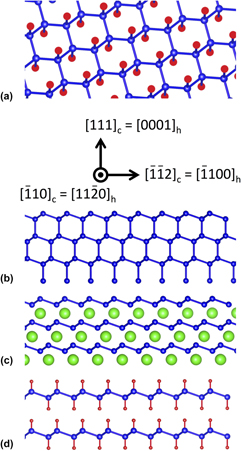Crossref Citations
This article has been cited by the following publications. This list is generated based on data provided by
Crossref.
Han, Wei
Kawakami, Roland K.
Gmitra, Martin
and
Fabian, Jaroslav
2014.
Graphene spintronics.
Nature Nanotechnology,
Vol. 9,
Issue. 10,
p.
794.
Katoch, Jyoti
2015.
Adatom-induced phenomena in graphene.
Synthetic Metals,
Vol. 210,
Issue. ,
p.
68.
Zhou, Yungang
Liu, Kezhao
Xiao, Haiyan
Xiang, Xia
Nie, Jinlan
Li, Sean
Huang, He
and
Zu, Xiaotao
2015.
Dehydrogenation: a simple route to modulate magnetism and spatial charge distribution of germanane.
Journal of Materials Chemistry C,
Vol. 3,
Issue. 13,
p.
3128.
Jiang, Shishi
Arguilla, Maxx Q.
Cultrara, Nicholas D.
and
Goldberger, Joshua E.
2015.
Covalently-Controlled Properties by Design in Group IV Graphane Analogues.
Accounts of Chemical Research,
Vol. 48,
Issue. 1,
p.
144.
Amamou, Walid
Odenthal, Patrick M
Bushong, Elizabeth J
O’Hara, Dante J
Kelly Luo, Yunqiu
van Baren, Jeremiah
Pinchuk, Igor
Wu, Yi
Ahmed, Adam S
Katoch, Jyoti
Bockrath, Marc W
Tom, Harry W K
Goldberger, Joshua E
and
Kawakami, Roland K
2015.
Large area epitaxial germanane for electronic devices.
2D Materials,
Vol. 2,
Issue. 3,
p.
035012.
Young, Justin R
Chitara, Basant
Cultrara, Nicholas D
Arguilla, Maxx Q
Jiang, Shishi
Fan, Fan
Johnston-Halperin, Ezekiel
and
Goldberger, Joshua E
2016.
Water activated doping and transport in multilayered germanane crystals.
Journal of Physics: Condensed Matter,
Vol. 28,
Issue. 3,
p.
034001.
Zhao, Jun
and
Zeng, Hui
2016.
Chemically functionalized germanene for spintronic devices: a first-principles study.
Physical Chemistry Chemical Physics,
Vol. 18,
Issue. 14,
p.
9809.
Zhao, Jun
and
Zeng, Hui
2016.
Two-dimensional germanane and germanane ribbons: density functional calculation of structural, electronic, optical and transport properties and the role of defects.
RSC Advances,
Vol. 6,
Issue. 34,
p.
28298.
Ng, A
Sutto, T E
Matis, B R
Deng, Y
Ye, P D
Stroud, R M
Brintlinger, T H
and
Bassim, N D
2017.
Chemically exfoliating large sheets of phosphorene via choline chloride urea viscosity-tuning.
Nanotechnology,
Vol. 28,
Issue. 15,
p.
155601.
Xu, Jinsong
Katoch, Jyoti
Ahmed, Adam S.
Pinchuk, Igor V.
Young, Justin R.
Johnston-Halperin, Ezekiel
Pelz, Jonathan
and
Kawakami, Roland K.
2017.
Growth of uniform CaGe 2 films by alternating layer molecular beam epitaxy.
Journal of Crystal Growth,
Vol. 460,
Issue. ,
p.
134.
Nijamudheen, A.
and
Akimov, Alexey V.
2017.
Excited-State Dynamics in Two-Dimensional Heterostructures: SiR/TiO2 and GeR/TiO2 (R = H, Me) as Promising Photocatalysts.
The Journal of Physical Chemistry C,
Vol. 121,
Issue. 12,
p.
6520.
Zhao, Jun
and
Zeng, Hui
2017.
Chemical Functionalization of Pentagermanene Leads to Stabilization and Tunable Electronic Properties by External Tensile Strain.
ACS Omega,
Vol. 2,
Issue. 1,
p.
171.
Ge, Yang
Ji, Jianlong
Shen, Zhizhong
Zhang, Qiang
Jian, Aoqun
Duan, Qianqian
Wang, Chao
Jiang, Jun
Zhang, Wendong
and
Sang, Shengbo
2018.
First principles study of magnetism induced by topological frustration of bowtie-shaped graphene nanoflake.
Carbon,
Vol. 127,
Issue. ,
p.
432.
Liu, Nana
Bo, Guyue
Liu, Yani
Xu, Xun
Du, Yi
and
Dou, Shi Xue
2019.
Recent Progress on Germanene and Functionalized Germanene: Preparation, Characterizations, Applications, and Challenges.
Small,
Vol. 15,
Issue. 32,
Katayama, Yumiko
Yamauchi, Ryoto
Yasutake, Yuhsuke
Fukatsu, Susumu
and
Ueno, Kazunori
2019.
Ambipolar transistor action of germanane electric double layer transistor.
Applied Physics Letters,
Vol. 115,
Issue. 12,
Ye, J.P.
Liu, G.
and
Han, Y.
2020.
Effect of electric field on the electronic properties of functionalized germanane by organic molecular adsorption.
Physics Letters A,
Vol. 384,
Issue. 17,
p.
126347.
Ahamed, Mohd Imran
and
Anwar, Naushad
2020.
Monoelements.
p.
235.
Uematsu, Yuto
Terada, Tsukasa
Sato, Kento
Ishibe, Takafumi
and
Nakamura, Yoshiaki
2020.
Low thermal conductivity in single crystalline epitaxial germanane films.
Applied Physics Express,
Vol. 13,
Issue. 5,
p.
055503.
Yu, Haoyang
Thiessen, Alyxandra N.
Hossain, Md Asjad
Kloberg, Marc Julian
Rieger, Bernhard
and
Veinot, Jonathan G. C.
2020.
Thermally Induced Dehydrogenative Coupling of Organosilanes and H-Terminated Silicon Quantum Dots onto Germanane Surfaces.
Chemistry of Materials,
Vol. 32,
Issue. 11,
p.
4536.
Hara, Kosuke O.
Kunieda, Shin
Yamanaka, Junji
Arimoto, Keisuke
Itoh, Mai
and
Kurosawa, Masashi
2021.
Close-spaced evaporation of CaGe2 films for scalable GeH film formation.
Materials Science in Semiconductor Processing,
Vol. 132,
Issue. ,
p.
105928.
